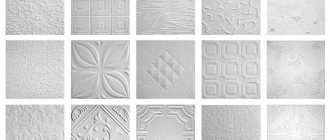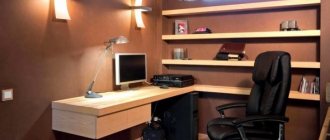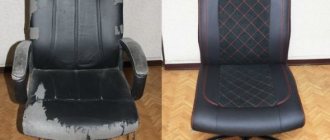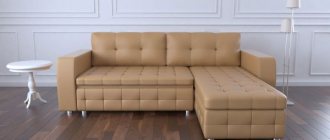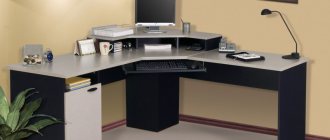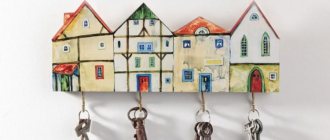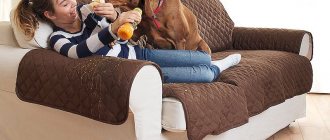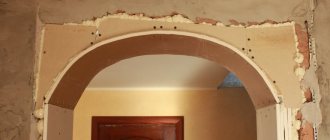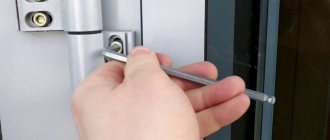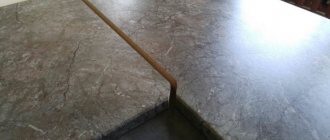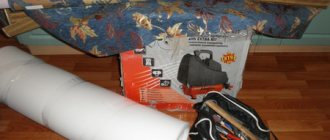Wear level
Depending on the intensity of use, the degree of wear of upholstered furniture and, in particular, a sofa, may vary. Typically, this requires various types of repairs. Sofa wear may include:
- The fabric covering is worn, but there are no visible dips in the soft part or protrusions. In this case, they can only get by by replacing the fabric covering, although it is not always possible to get off so easily.
The simplest case is if you need to replace the fabric - There are pressed places available. This is mainly due to the wear and tear of the springy parts of the sofa, so you will also have to deal with the soft part, replacing the padding polyester and other underlying layers. The spring blocks may also need to be repaired and replaced. The spring block can consist of springs, foam rubber or silicone. If the appearance of the upholstery is not damaged, then it is washed and used again, although there is no point in this.
- In the failure of the lower part. If the bottom of the sofa is sewn up with a material such as fiberboard, then it may not withstand heavy loads, as a result of which the spring block simply breaks through the bottom of the frame. It’s better to take everything apart and replace the fiberboard with plywood.
This one needs more than just upholstery replacement... - Damage to frame elements. In wooden structures, as a result of prolonged use under conditions of increased loads, cracks appear, which leads to breakage of such structural elements. In this case, the sofa is completely disassembled and all elements that are cracked or broken will have to be replaced. In fact, we can talk about assembling a new sofa, since the sofa will have to be reupholstered.
In other words, repairing a sofa involves a whole range of repair activities, so we can’t just talk about simply replacing the upholstery. If the sofa is equipped with a spring block, then the work can become significantly more complicated. The fact is that reupholstering such a sofa requires considerable skill, so it is better to immediately throw away this block, replacing it with foam rubber or furniture silicone. The result is a design with many advantages, and the effect of comfort will be felt immediately.
Features of do-it-yourself banners
If the upholstery has lost its attractive appearance, has indelible stains, holes, or scuffs, it must be replaced. If there is damage to the frame, it can also be repaired in most cases. Not wanting to throw away comfortable, familiar furniture, many people restore it themselves.
Upholstering a sofa with your own hands has many advantages:
- This is an interesting creative process that requires accuracy and ingenuity;
- cheap - it will be more expensive to transport furniture to the workshop;
- Almost any material you like is suitable for decoration;
- an easy way to preserve an antique;
- the bases of old sofas are much stronger than modern ones;
- You don’t have to throw away your favorite piece of furniture;
- You can easily change the design of the sofa.
There are also disadvantages:
- For high-quality furniture repairs, you need some tools and skills to work with them;
- when using excessively expensive materials, the costs will be high;
- a beginner will need a lot of time to disassemble and assemble a piece of upholstered furniture.
When upholstering yourself, the upholstery fabric is selected to match the existing or planned interior style. The finished product can be combined in color and texture with curtains, carpets, chair covers, other home textiles, and contrast with the floor covering and general background.
The simplest way to change the appearance of upholstered furniture is to sew bedspreads and original pillows for it.
Design of the soft part of the sofa
The soft parts of the sofa are made in 2 versions: without springs and with springs.
If springs are not used, then:
- High density foam is used.
- Foamed latex is used, although it is more expensive than foam rubber, but it is more elastic.
If springs are used, then:
- Conventional springs are used, which are connected into a single unit.
- Snake springs are used in combination with foam/latex filling.
When restoring a sofa, you need to examine the layers
As a rule, these are the most common design solutions. If a complex option is offered using springs, as well as a layer of latex or polyurethane foam, then these are the most expensive models. Reupholstering such products is a troublesome task and requires professionalism.
The structure of sofa seats can be multi-layered
In fact, there may be more layers, since padding polyester or thermal felt is also added. But this option is not so expensive, although more modern. Some models may contain burlap, matting, batting, horsehair, dried seaweed, etc. Sometimes very exotic materials are used and finding replacements is not so easy. Therefore, it is better to replace them with similar materials, selecting the desired thickness. In any case, first of all, the sofa should be disassembled in order to understand what is inside this structure in order to determine the nature of wear of its elements.
Preparation
At the preparatory stage of reupholstering an old chair, no special actions are required. You just need to choose the right fabric with additional impregnation against dirt and wear, and also prepare all the necessary tools
It is important to immediately understand what the end result will look like, and therefore buy the materials yourself rather than order them on the Internet. It should be remembered that an overly old chair cannot be restored at home, and it is better to leave this task to a specialist
Otherwise, the seat or legs may fall apart, and the furniture will have to be thrown away. Professional craftsmen also recommend photographing the chair from different sides in order to assemble it without any problems in the future.
The process of disassembling the sofa
The main thing is to remove the old upholstery.
Then everything will become clear. Repairing a sofa begins with disassembling it, since without this it will not be possible to assess the degree of wear of all structural elements. To disassemble the sofa you will need some tools such as:
- A large, heavy-duty screwdriver because it's hard to get the joints loose after so many years of sitting.
- A small screwdriver and pliers to remove the staples that secure the upholstery.
You may need open-end wrenches, but this minimal set of tools is enough. Since designs may vary, you may not hear specific recommendations. If there are retractable parts, then it is better to get rid of them first, then the picture may become clearer. The main thing is to do everything in order, unscrewing all visible fasteners, and remember the order of their location, so that after the repair you can assemble them in the same order.
Removing the upholstery
If the upholstery has not lost its attractive appearance, then first of all it is better to deal with this material. The fabric (and maybe other material) is attached to the frame of the product using metal staples. To pull out the bracket, you need to take a flat-head screwdriver and pry it off (sometimes force is required), after which it is taken with pliers and pulled out.
We disassemble the sofa: remove the staples
The fabric must be removed carefully so as not to damage it. This is especially true if you plan to use it. In addition, the fabric can be used as a sample by cutting new upholstery fabric from it. Under the upholstery there may be several more layers of materials such as padding polyester, felt, etc. If you plan to change only the upholstery, you will have to evaluate the condition of these materials, although it is better to replace them. In any case, these materials are already outdated both morally and physically.
If the sofa is old, there may be a picture like this
After removing the upholstery, it is easy to assess the condition of all other structural elements, including the frame. It is very important to maintain all dimensions of the product, since the folding mechanism is designed for certain sizes. When replacing old worn-out elements with more modern ones, it is better to stick to the factory thickness. You should not try to make the backs more voluminous, as this may affect the functionality of the upholstered furniture. In other words, the sofa may not be able to be folded out after such a repair.
Wear assessment
The degree of wear of the furniture is assessed after disassembling it, but if, apart from the upholstery, the other functions of the furniture are not impaired, then pay attention to the additional filling under the upholstery. If there is foam rubber under the fabric, then it is better to replace it with high-density foam rubber, folding it in several layers. Alternatively, foam rubber can be ordered from a store that sells spare parts (accessories) for furniture. It is better to take accurate measurements and order a latex mattress, but this is best done after removing the upholstery and filling. Such a mattress will cost a pretty penny.
With sofas based on springs, everything is somewhat more complicated, especially if worn springs are found that require replacement. If the springs are securely fastened, have no backlash, and the base is not damaged, then it is better not to touch the springs, focusing solely on filling and upholstery.
Broken spring
Inspect the spring block for broken springs
Torn spring snakes
Chipboard frame broke
Typically, spring units fail because the springs break. In this case, it is better to replace the spring block, since the probability of breakage of the remaining springs is too high. Springs are attached to the base in different ways. If you remove the spring block, you can say that the sofa is completely disassembled. After this, they begin to replace the worn elements, and then the sofa is assembled in the reverse order.
How to fix springs in a sofa
Choosing new upholstery
To determine the required size of material, measure the length and width of the old upholstery. When you buy new fabric, just in case, take it with a 10-15% margin in size.
It is very important to choose the right upholstery material. Do not use rough or artificial fabrics. If the material has a strong synthetic smell, then it cannot be used for upholstery. The fabric should not fade or leave traces of paint. It is also not recommended to use chinillas or leatherette when reupholstering. These are cheaper materials, but they quickly become unusable, so soon you will have to reupholster again.
We recommend using high-quality tapestry or genuine leather for upholstery.
Tapestry
Tapestry is quite durable and not too expensive material. There are practically no puffs on it. It is best to use a tapestry with an abstract pattern or even a plain one. If you use a complex pattern, you will have to customize it. This complicates the work and increases material consumption.
Leather
Working with leather is not as difficult as it is thought. For furniture upholstery, leather with a thickness of 1.5-2 mm is used. This leather retains its elasticity and is easy to fasten and even stitch if necessary. Work with dry skin. Wet skin becomes very stretched when dried.
Problems with a sofa with a spring block
First of all, it is necessary to have information about the order in which the layers of materials are placed. If you have a sofa with a spring block, then the sequence of arrangement of materials is as follows:
- The first is the frame, which can consist of wooden blocks or plywood. Naturally, a plywood frame is stronger and more reliable, but it is more expensive, and there is more hassle with it. Therefore, frames made of wooden blocks are mainly found. Pine bars are joined by applying wood glue to the joints. For greater reliability, connections are duplicated using metal corners.
What layers should there be in a sofa seat? - Then there is a base that holds the spring block. The base can be made using different technologies and from different materials. The cheapest option is a base made of fiberboard, and the most expensive is based on lamellas that are attached to special stops. If the stops are plastic, they break quickly. It is possible to use low-quality lamellas or place them at slightly larger intervals to reduce the cost of the products. As a result, the lamellas are pressed through (break). Instead of wooden slats, some manufacturers use snake springs. Although this reduces the cost of the design as a whole, it does not eliminate problems.
This is what the slats look like from below - The spring block is structurally composed of dependent or independent springs. The presence of independent springs reduces the cost of upholstered furniture, and dependent springs create a certain level of comfort, which is why such designs are called orthopedic.
- Pad made of felt or thick fabric. Their role is to prevent the springs from pushing through the next layer of foam rubber.
- Polyurethane foam (foam rubber). As a rule, special high-density foam rubber is used. When choosing this material, you should pay attention to such an indicator as the durability factor. The higher the number, the better, although such material is more expensive. This indicator indicates how quickly after removing the load this material acquires its usual shape. This layer can be made thicker only if the furniture cannot be folded out.
- A padding polyester layer protects the foam from abrasion. It is better to fix the synthetic winterizer on the surface of the foam rubber using special glue, otherwise the material will gather in folds.
- Layer of upholstery fabric. The most preferred option is to use tapestry or chenille. In addition to being easy to work with, they do not fray. If you take flock and jacquard, you need to know that over time their seams come apart. In this case, the seams will have to be additionally fastened. The upholstery is sewn with special durable threads of the “Tytan” brand, and ordinary threads, although thick, will quickly tear.
It is not advisable to remove layers, but you can add them, within reasonable limits. For example, an additional layer of padding polyester would not hurt.
Choosing a new filler
Foam rubber or padding polyester is usually used as filler in upholstered furniture. The filler not only makes the furniture soft, but also protects the internal parts from damage.
Foam rubber
When choosing foam rubber, its porosity and density are assessed. Inspect the material. If the foam rubber consists of small bubbles, then it is a high-quality material. Large bubbles are a sign of low-quality foam rubber. Such material easily loses its elasticity and ability to take its original shape. The foam rubber will quickly begin to crumble.
To check the quality, squeeze the foam in your hands. The material should instantly return to its original shape. If the foam straightens slowly, then it is a low-quality material.
Do not use foam that has just been unpacked. When packaging, the material is greatly compressed. Only after a few days will it take on its real shape and size.
For upholstered furniture, foam rubber with a density of 25-45 kg/m3 is used. You should not take very hard material. Although it will last a long time, it will be uncomfortable to sit on. For the seat, two layers of foam rubber of different hardness are often used: the bottom is denser and the top is softer.
Sintepon
Sintepon for furniture should not have a strong, toxic odor. The material must be white. If at least in some places there are other shades, then this is a sign of low-quality padding polyester. This means that recycled or toxic materials were used in production. The padding polyester should be equally smooth and dense in all areas. Also, a good padding polyester is difficult to tear apart with your hands; it does not crumble or delaminate.
Pieces of filler of the required size are cut from the selected material. If necessary, they are glued and fixed to the frame. This must be done before the new upholstery is made, as we will need to do fittings.
Snake springs and possible problems
Often such springs are used in more expensive upholstered furniture to increase the level of comfort by improving elastic properties. As a rule, cheaper products use a layer of foam rubber. The springs are attached to a frame made of wood or metal, and each spring has no connection with adjacent springs (independent option). The distance between the springs depends on the planned load. When the sofa does not spring and begins to sag, the repair comes down to a complete replacement of the spring block.
Spring snakes
To extend the service life and increase the springing properties of the block, during repairs you can increase the number of springs or strengthen the block with corsage ribbons; in any case, the old springs are removed.
For durability and greater elasticity, use grosgrain ribbon
On the one hand, the tape is nailed to the frame and then tensioned using a special tool. Alternatively, you can take a regular block and wrap it in coarse sandpaper. A couple of turns of tape are wound around this block and pulled with maximum force. All that remains is to secure the tape to the frame and then trim off the excess tape. In the same way, you can increase the service life of mattresses with slats.
Video tutorial “Upholstering a sofa with your own hands”
Required Tools
We have chosen the fabric - it must be taken with a margin for the possibility of error, now we will prepare the tools that will be needed: a sewing machine, a set of needles, strong threads (polyester), a flat-head screwdriver, a hammer, an anti-stapler to remove old staples, pliers, wrenches (from 8 up to 19 mm), side cutters, furniture stapler, scissors, staples (6-8 mm), sewing meter, square, metal ruler, chalk, screwdriver, drill, glue.
The necessary set of tools.
Sofa repair step by step with photos
They begin to repair the sofa when it becomes uncomfortable and begins to sag and creak. Not always and not everyone has the opportunity to purchase a new one. In this case, you have to do repairs by reupholstering and upholstering the furniture with new fabric. Nothing will work if you don’t disassemble the sofa, so they start disassembling it. First of all, the legs are removed, and then the railings (armrests), which are attached with only 2 bolts. To remove these parts, it is better to use a key, then there will be fewer problems. After this, all the bolts that appear are unscrewed.
Dismantling the sofa
Finally, the old upholstery is removed. To do this, you need to remove the staples, which during this time have become very loose in the pine beam. After disassembly, it may turn out that the spring block is not broken, but the frame has a crack, since one beam of the frame has twisted. The bottom of the structure, which is covered with fiberboard, can also sag.
How to fix the frame
Since the entire load falls on the frame, it is better to replace defective elements. To do this, you need to measure all the parts that require replacement and draw the parts on paper indicating the dimensions in millimeters. With the design and dimensions, you should go to a carpentry shop, although you can do it yourself if you have the material and the skills to work with wood. The main thing is that the material for production is sufficiently dried.
Defects close up
All elements are connected classically, using the tongue/groove method, coated with wood glue. To ensure reliable connection, it is reinforced with metal dowels.
Reassembling the frames
First of all, the joints are coated with glue, connected and clamped using a vice or clamps. To drive a dowel, a small diameter hole is drilled under it. The dowel is driven in with a hammer. Further operations are carried out after the glue has completely dried, releasing the part from the vice.
The basis for the spring block can be plywood instead of fiberboard. A thickness of no more than 5 mm is sufficient. The standard dimensions of plywood sheets are a little more than 1.5 meters, so the base will have to be made from two pieces, since the length of the sofa is almost 2 meters. It is better to join pieces of plywood at the joints of the frame or by adding another jumper in the center: this will be more reliable and stronger. Before attaching plywood sheets, it is better to coat the frame with wood glue. Fastening is carried out with small nails: it’s easier and faster, so as not to bother with screws, since you need to drill holes for them.
Let's start re-upholstering the sofa
Since the sofa after renovation is planned to be installed in the country house, the costs should be minimal. You can use an unnecessary old blanket as a backing for the springs. The blanket is well stretched and attached to the base using staples, armed with a construction stapler.
The base for the springs is an old fleece blanket
If possible, you can add a layer of thermal felt or get by with one layer of this material. It's not that expensive, but much more reliable. Nails with wide heads or staples can be used as fasteners.
Attaching the spring block
Since the springs are subject to serious loads, it is better to secure them using powerful U-shaped brackets. It is advisable to use staples with sharpened legs. If this is not possible, then you can make similar staples yourself from wire, after which they are driven into the base with a hammer.
Updating the sofa at home: attaching a spring block
The springs, in addition to being attached to the frame, require fixation among themselves, otherwise the spring block will “ride.” To perform the following operation, you can take the twine, fold it in half and secure it to the base with the same staples. The twine should be tensioned so that the springs are not pressed in, but the tension is noticeable.
A fairly dense material in the form of felt should be laid on top of the springs. Alternatively, you can use old flooring that is similar to felt. This coating is quite dense and durable, especially if it is folded in half. This layer is necessarily attached to the spring block. Since the material is quite dense, you will have to tinker a lot, making holes in it and threading a thick thread. The stitches are made in increments of about 4 cm. The best way out is to use a shoemaker's tool.
Upholstery of a sofa from scrap materials (budget upholstery of a sofa)
The next layer, according to the diagram, is foam rubber, and then padding polyester, but in fact they can be replaced with other materials, as long as they are elastic, like foam rubber, and dense, like padding polyester. Instead of padding polyester, another old, unnecessary fleece blanket will do. The blanket will not “move” if it is tied around the perimeter with threads.
Making a cover and covering it
If the shape and design of the sofa is simple, then upholstering it will not be difficult. You will have to take and rip open the old cover, and then a pattern is made from it, and you can take new, but cheap upholstery fabric. In the places where the pillows and seats meet, a thick tape made of durable fabric should be sewn on the back of the fabric, otherwise these places will quickly fray. To prevent the edges from fraying, the fabric is tucked: there is no point in processing them further.
We put the finished part in the case
The prepared cover is laid out on the floor, and the restored part of the sofa is placed on top. It is very important to ensure that the fabric is stretched evenly during the fastening process. The cover is fixed in the direction from the center to the edges. It is better to use thick staples, otherwise you may damage the fabric.
The sofa is almost finished
The back of the sofa is restored in the same manner. Lastly, the armrests are covered. The final stage comes down to securing all the restored elements to the folding mechanism. If all dimensions have been met, then there should be no problems.
The reupholstery of the sofa is finished. Result verified
The test results showed that the sofa turned out to be somewhat harsh, but for a summer house this is exactly what is needed. If you are repairing a sofa for your home, such repairs will not add comfort, so it is better to use classic materials rather than inventing what is simpler and cheaper: you should not skimp on comfort.
How to sew upholstery on a sofa. Cutting fabrics and sewing a cover for upholstering a corner sofa
Sew covers to cover the sofa from furniture fabric. You should not use, for example, a curtain. The parts are sewn together using a regular connecting seam. If you have enough skill, the seams on the seats can be made with double stitching (4-7 mm between lines).
The fabric cutting pattern is given for a 1.4 meter wide fabric. Most furniture fabrics have this width. 10.2 linear meters of fabric are required. The fabric is cut wrong side up. Don’t confuse the side of the sofa, you can see what our sofa looks like here, if your sofa is on the other side, then you need to cut all the details in a mirror image.
We upholstered the sofa with flock fabric. Seam allowances are made in the amount of 1 cm (that is, the cutting diagram is given with exactly these allowances). If the edge of your fabric frays a lot, you may need to increase your seam allowances or overlock the seams.
In the diagram, the parts are pink, gray is waste fabric (which, however, is also useful). Dimensions are given in centimeters. Other designations:
– cut line
– dimension line
- detail number
For the case, you can make a pattern for parts 14 and 15 yourself. Simply attach a piece of fabric or paper to the foam-covered frame or use the pattern sheet:
Layout of the cutting details on the upholstery of the finished corner sofa:
The picture below explains how to sew a cover for a lifting sofa seat. The width of the fabric will not allow us to cut out the part in one piece, so we slightly lengthen part number 1 with part number 9. In addition, we make a rounding on the back to make it easier to raise and lower the seat.
Parts 16 are pillows.
If you want to have point tightening (recesses) on the sofa seat, you need to sew them to the fabric in advance. How to do this can be seen in the picture below. Not only will tension bands change the look of your sofa, but they will also help hold the fabric in place, reducing the formation of wrinkles on the surface of the sofa seat. We sewed the drawstrings in increments of 25 cm and drilled holes for them (more details here and here)
You can leave your comments and questions in the Guest Book
All rights reserved © 2007 – NovaMebel74 When copying materials, an active hyperlink to the source is required.
Transportation rules
An important point when transporting furniture is to prevent it from moving freely in the back of the car. To do this, you need to secure it with a rope or stops. To avoid accidental staining, lay it down with cardboard. Try to initially place the overall part in the body of the vehicle, and the sidewalls and blocks can be placed nearby as stops. It is better to put pillows and other small items on top. It is advisable to use freight transport for transportation, but in order to save money, you can transport it in your own passenger car. To do this you will need a roof rack and a large interior. The main part of the sofa can be secured on top; before doing this, it is advisable to pack it well; it is better to transport small parts in the cabin and rear trunk.
Recommendations
In order to avoid damaging the structure during the move, you should take into account some recommendations from specialists. Expensive sofas are often equipped with branded fasteners
To disassemble it, special tools are required, otherwise there is a possibility of damaging the upholstery or frame.
You should not try to disassemble such mechanisms yourself; it is better to seek help from professional craftsmen.
Caution also applies to individual models. The accordion mechanism often has special clamps in its design.
Removing the laundry storage box can be difficult. In the “book” and “eurobook” models, it is recommended to tighten the nuts onto the bolts immediately after dismantling.
There are a lot of these elements, they are very easily lost. In a corner folding sofa, it is the corner block that deserves attention.
It is non-removable, so it should be left in its original condition.
During debriefing, many problems arise after severe physical force is applied. This is strictly prohibited.
This is especially common if a compact folding mini-sofa is disassembled. All items are carefully stored in a specially prepared place so as not to lose them when moving.
This will help you quickly assemble the sofa in the new room.
When disassembling furniture with an old base, several nuances should also be taken into account. Repairing chipboard is more difficult compared to a sofa with a wooden frame. A lot depends on the condition of the frame.
Expert opinion Ekaterina Anatolyevna Smirnova has been engaged in interior design for 7 years, a professional architect
It is also important to take into account the age of the structure, since over time the fastenings will fit closer and closer to each other. Disassembling corner models can be more difficult compared to straight ones
During transportation, care must be taken to ensure that no moisture gets on the elements.
It is best to use a polymer film that is impermeable to water; it will hide the parts from unwanted exposure.
Caution is also required when working with draw-out models. This is especially true for families with pets.
Therefore, before you return the built-in compartment for storing bed linen to its place, it is worth checking that your pet will not hide in it. If this is not done, the animal may be injured.
When disassembling, not only the structure itself deserves attention, but also its dimensions, transformation mechanisms and material of manufacture. Experts recommend using only tools that are suitable for working with a specific model.
It is important to follow the dismantling sequence. If all conditions are met, there will be no problems during the work, and the product will be very easy to assemble in a new place
Using the example of assembling an accordion sofa, you can easily disassemble this model for transportation. All the details are in the video below.
Stage V - making a pattern
Once a suitable fabric has been selected, you need to cut it into fragments. To simplify the process, use old upholstery, which must first be shaken out or vacuumed well.
Spread the fabric on the floor and place all the pieces of the old upholstery you removed on it. Keep the layout as compact as possible, but do not forget to leave an allowance around the edges if you need to sew the covers together. Thus, between each part you should have gaps about 8-10 cm wide. Now you need to circle all the elements. Use a bar of soap or chalk for this if the fabric is dark, and a simple pencil if it is light. To avoid the parts moving, you can pin them using sewing pins. Now you need to sew covers for the sides and other elements, if this was the case initially. It’s good if you have a sewing machine at home and you’re comfortable with it. Otherwise, you need to contact the studio for help and be sure to ask that all edges be overlocked. This will protect the edges from fraying.
It is very important to monitor the direction of the weft and warp threads. They must match on all parts
It is very easy to determine - the weft thread stretches, the warp thread does not.

